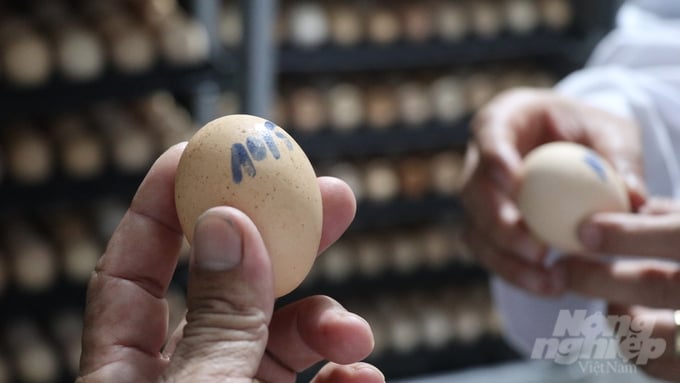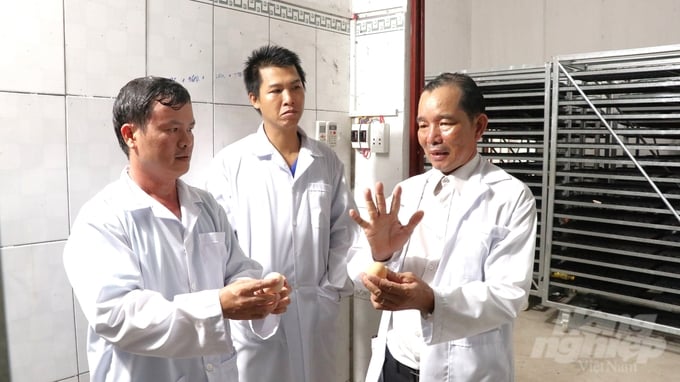May 29, 2025 | 04:14 GMT +7
May 29, 2025 | 04:14 GMT +7
Hotline: 0913.378.918
May 29, 2025 | 04:14 GMT +7
Hotline: 0913.378.918

Mr. Khuong's poultry farm, spanning nearly 30,000 square meters, is invested and constructed to meet strict biosecurity standards. The farm employs a closed-process approach to producing laying hens. Photo: Tran Phi.
During its process of agricultural and rural industrialization, modernization, Binh Duong province has implemented an increasing number of production models that utilize scientific and technological advancements. This approach is a sustainable development direction that enables farmers to increase profits and move towards clean agriculture, thereby promoting disease prevention and environmental protection.
Poultry farming is a familiar occupation among the farmers of Binh Duong province. However, local farmers previously engaged in small-scale household farming, which resulted relatively low economic efficiency. With the modernization of agriculture over the years, Binh Duong province has implemented various livestock production models that utilize scientific and technological advancements to bring high economic efficiency. A notable example within this initiative is the poultry farming model belonging to Mr. Dinh Ngoc Khuong in Nuoc Vang hamlet, An Binh commune, Phu Giao district, Binh Duong province.
Mr. Khuong is known by locals and farmers from neighboring provinces for his "secret" of cold poultry farming, which involves utilizing closed chicken coops with air conditioning, automatic water troughs, feed trays, among others. Mr. Khuong poultry farming model boasts high economic efficiency; and he was recognized as an outstanding farmer nationwide in 2021 by the Central Committee of the Vietnam Farmers' Union.
According to Mr. Khuong, the high-tech laying hen farming model began with a transition from open to closed farms with air conditioning systems and other necessary food, water supply systems. This model reduces the need for antibiotics, requires fewer workers, and shortens the farming cycle from 60 days in open farms to 52 days in closed farms before the chickens are marketable.
Mr. Khuong's poultry farm, spanning nearly 30,000 square meters, is invested and constructed to meet strict biosecurity standards. The farm employs a closed-process approach to producing laying hens with more than 400,000 commercial chickens and 40,000 parent chickens, and an average of 15,000 to 17,000 eggs per day from the parent flock.
Mr. Khuong selects large and well-formed eggs for the incubation process, producing chicks with exceptional resistance and potential for development. Accordingly, he invested in 12 modern incubators to produce breeding chickens. During peak seasons, his cold poultry farm raises 600,000 commercial chickens, with a monthly output of 20,000 chickens, averaging 900 tons of chickens per month.

Mr. Khuong selects large and well-formed eggs for the incubation process, producing chicks with exceptional resistance and potential for development. Photo: Tran Phi.
Mr. Khuong is currently partnering with two local companies in order to maintain the farm's commercial chicken output. "The agricultural sector is also promoting digital transformation, which is an opportunity for farmers to access advanced, high-tech, and cost-effective agricultural production models," Mr. Khuong shared.
It is projected that Mr Khuong will achieve a revenue of approximately 100 billion VND in 2024. This achievement demonstrates that the application of high technology in cold poultry farming, and in farming models as a whole, is the key to new opportunities for farmers.
Furthermore, Mr. Khuong noted that the cold poultry farming model has not seen widespread adoption in Binh Duong province; and he encouraged farmers to invest in the model if able. According to Mr. Khuong, despite the model's high economic efficiency, farmers require both capital and knowledge of poultry farming in order to pursue this profession.

Mr. Khuong's success has become well-known among locals and farmers from neighboring provinces; consequently, numerous people have visited his farm to learn about the cold poultry farming model. Photo: Tran Phi.
When asked, "What factors contributed to your success today?" Mr. Khuong responded, "My achievements are the result of numerous failures and a continuous pursuit of knowledge through various channels."
Mr. Khuong's success has garnered the attention of locals and farmers from neighboring provinces, with many seeking his expertise in cold poultry farming model. His farm currently provides employment for several local residents. He has also provided training to farmers from various provinces across the country.
"I am always willing to share and pass on everything I have learned and experienced to anyone who comes to me. In my opinion, my success is only truly valuable if I can share it with others," Dinh Ngoc Khuong remarked.
Translated by Nguyen Hai Long
/2025/05/25/4127-3-073637_820.jpg)
(VAN) Thanks to the promotion from an FAO-implemented project, vegetable production in greenhouses in Moc Chau has seen strong development, from 1.5 hectares in 2021 to nearly 50 hectares in 2024.

(VAN) FAO has recently supported USD 140,000 to implement the project 'Risk mitigation human-animal interface risks through disease control initiatives in pig farming.'

(VAN) The People's Committee of Tra Vinh province has approved an adjustment to the investment policy for the Green Hydrogen Plant project, increasing its area to approximately 52.76 hectares.
![Reducing emissions from rice fields: [2] Farmers’ commitment to the soil](https://t.ex-cdn.com/nongnghiepmoitruong.vn/608w/files/news/2025/05/05/dsc08881jpg-nongnghiep-140632.jpg)
(VAN) Clean rice cultivation model in Thuong Tan commune, Bac Tan Uyen district, is assisting local residents in achieving sustainable agriculture by substantially reducing costs, increasing productivity, and protecting the environment.

(VAN) At the conference to disseminate Resolution No. 68, AgriS introduced its digital agricultural ecosystem and reaffirmed its commitment to accompanying the Government in promoting private sector development and sustainable agriculture.

(VAN) 'Blue Ocean - Blue Foods' initiative is designed to restore marine ecosystems and establish sustainable livelihoods for local communities by cultivating a minimum of 1,000 hectares of cottonii seaweed in the first three years.
/2025/05/21/4642-3-112707_603.jpg)
(VAN) The V-SCOPE project has made direct contributions to three out of six pillars of the Comprehensive Strategic Partnership between Vietnam and Australia.